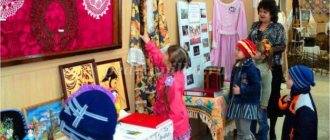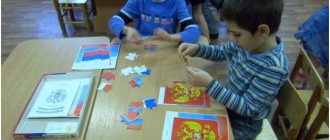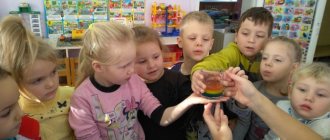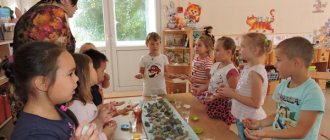Description of work experience “Experimental activities in preschool educational institutions”
Olga Kostrikova
Description of work experience “Experimental activities in preschool educational institutions”
My name is Kostrikova Olga Vitalievna! research with children . I took advanced training courses in this area. Participated in the regional pedagogical conference of preschool educational institutions employees , where she presented her work experience in the form of a presentation . Received a diploma for the best presentation of experience at the Kansk pedagogical conference of the eastern educational district of the Krasnoyarsk Territory “Modern practices of preschool education at the stage of implementation of the federal state educational standard”, Presented at the regional methodological association master class on speech development using elements of experimental activities . Many times she gave open classes for teachers in the region and city.
Currently, the latest developments , technologies, and methods are being formed and successfully applied in the preschool education system, which make it possible to raise the level of preschool education to a higher and higher quality level. One of such effective methods of understanding the patterns and phenomena of the surrounding world is experimental research activities . Children love to experiment . This is explained by the fact that they are characterized by visual-effective and visual-figurative thinking. Therefore, experimental research activity , like no other method, satisfies age characteristics. In preschool age, experimentation is the leading one , and in the first three years it is practically the only way to understand the world.
experimentation method contributes to the formation of integrative qualities of a preschooler. Ensures the integration of educational areas: “Cognitive development”
,
“Social and communicative development”
,
“Speech development”
,
“Artistic and aesthetic development”
,
“Physical development”
.
Develops the child’s interest in the world around him, activity, initiative and independence in his knowledge in the course of practical activities .
Developing a child’s research abilities is one of the most important tasks of modern education. Knowledge obtained as a result of one’s own experiment and research search is much stronger and more reliable for a child than information about the world that is obtained through reproductive means.
The main advantage of experimental research activities is that it is close to preschoolers (preschoolers are natural researchers, and gives children real ideas about the various aspects of the object being studied, about its relationships with other environmental objects.
During the experiment in addition to the development of cognitive activity , there is a development of mental processes - enrichment of memory, speech, activation of thinking, mental skills, since the need constantly arises to perform operations of analysis and synthesis, comparison and classification, the need to give an account of what was seen, to formulate discovered patterns and conclusions ; Not only does the child become familiar with new facts, but also the accumulation of a fund of mental techniques and operations.
Requirements for the modernization of education - the search for new effective forms of teaching preschoolers. In paragraph 4.6. The Federal State Educational Standards target guidelines say that it is necessary to develop in children initiative and independence in cognitive and research activities . In practice, this is carried out through the ability of children to independently perceive simple and complex experiments and draw conclusions. In the children's research laboratory, children can independently reproduce simple and more complex experiments .
I believe that in search and research activities, a preschooler gets the opportunity to directly satisfy his inherent curiosity and organize his ideas about the world. Therefore, I strive to teach not everything, but the main thing, not the sum of facts, but their holistic understanding, not so much to give the maximum information, but to teach how to navigate its flow. I want children to be attracted to experiments not only by the spectacle (changes in color, shape of liquid), but also by an understanding of how to apply this in life.
base my work on children's experimentation on the following ideas :
- a general focus on obtaining new information about a particular object, phenomenon, substance (what new we learned today by conducting experiments with air )
;
- obtaining new knowledge and information, something new, unexpected (Did you like learning the properties of air? Do you want to explore these properties further);
- accumulation of generalized research methods and methods (now you know that air is lighter than water and how this can be checked)
.
When analyzing the activity , I emphasized what has already been achieved and what needs to be strived for, namely, the children learned to analyze, draw conclusions, and can themselves explain some patterns in nature. They conduct experiments and create the conditions for conducting experiments and observations . They are responsible for doing homework. a lot of experimental activities with the children of my group, but there is still something to strive for, that is, I want the children to be able to independently:
- identify and pose a problem that needs to be resolved;
— offer possible solutions;
— test these possible solutions based on data;
— draw conclusions in accordance with the results of the inspection;
- make generalizations.
As part of the implementation of the main educational program of the preschool educational institution, in the educational field of “cognitive development”
,
the work is aimed at achieving the program goal, developing cognitive and research activities . Obtaining positive results in children’s mastery of cognitive-research activities is due to taking into account the age and individual characteristics of preschoolers and the gradual complication of program material (if in the younger group we introduce children to general methods of studying various objects and include children in practical cognitive activities jointly with adults, then in the senior preschool age, we consolidate the ability to use generalized methods of examining objects and develop the ability to determine an algorithm of activity ).
In my research work , I give preference to experiments , experiments , research activities, and independent search activities of children . I see that this type of activity delights children. Experience is fun and exciting, but at the same time, in each experience the cause of the observed phenomenon is revealed, children are led to judgment, conclusion, their knowledge about the properties and qualities of objects, about their changes is clarified. I carry them out both in educational activities and in free independent and joint activities .
Children with great pleasure conduct experiments with objects of inanimate nature: sand, clay, magnets, fabrics, snow, water, air. For example, in order to find out if there is air around us, I suggest children catch it with the help of bags, and then determine what color it is? Having collected air into bags, the children argue that it can be caught, which means it is around us and that it has no color. This is how I introduce children to the properties of air.
From experiment , when water and syrup interact, we learned about its ability to change color, the “Magic Mitten” experiment
helped to find out the ability of a magnet to attract metal objects through a mitten.
Such experiments somehow remind the kids of magic tricks, they are unusual, and most importantly, the kids do everything themselves. Our relationships with children are built on the basis of partnership. Children learn to set goals, solve problems, put forward hypotheses and test them empirically , and draw conclusions. They experience great joy, surprise and even delight from their small and big “discoveries”
which give them a feeling of satisfaction from
the work .
talk endlessly about the experiments and discoveries of young students. I have been convinced in practice that experimental activity is , along with play, the leading activity of a preschool child . The main thing is that the child’s interest in research and discoveries does not fade over time.
Perhaps in the near future, from "Know-It-Yourself"
and
“Whychek”
, graduates of my group will grow up and become outstanding scientists. At school, many children are already excellent students and athletes who defend the honor of the school and the region.
With the introduction of the Federal State Educational Standard, I am paying great attention to working with parents. Cooperation presupposes not only mutual actions, but also mutual understanding, mutual respect and trust. Active joint work helps strengthen relationships between all participants in the educational process. I consider the main tasks in interaction with parents to be:
— firstly, to establish partnerships with the family of each pupil and join efforts for the development and upbringing of children;
- secondly, create an atmosphere of community of interests;
- thirdly, to activate and enrich the educational skills of parents.
Parents take an active part in the “ Experiments at Home ”
,
"Why is that?"
help in equipping and replenishing our group’s laboratory with the necessary materials.
In individual conversations, consultations at parent meetings, and through various types of visual propaganda, I convince parents of the need for daily attention to children's experimentation . Conducted a parent meeting on the topic “Children’s
experimentation in kindergarten and at home” , a survey of parents in order to identify their attitude towards the search and research activity of children
The group has an information corner for parents on research activities . In it, parents can get advice on the topic: “Organizing children’s experimentation at home ,” booklets and recommendations: “Conducting experiments at home ”
, read the memo
“
Experimenting with water ” .
My group has created a laboratory for experimental activities in which we conduct research.
Indoor “Merry Garden”
, where together with children we grow and watch how plants grow and develop.
“Seabed” piggy banks have been collected
,
"What's Under Our Feet"
;
• Instruments – assistants for experimentation : scales, magnets, magnifying glasses, hourglasses;
•Natural materials: sand, clay, earth, seeds, pebbles of different colors and shapes, minerals, clay, earth of different compositions, coal, salt, shells, cones, nut shells, pieces of tree bark, fruit and vegetable seeds.
•Medical materials: pipettes, flasks, syringes, measuring spoons, cotton wool, bandages, test tubes, spatulas, wooden sticks, beakers, funnels, rubber bulbs of various sizes.
• Waste material: plastic, pieces of fabric, leather, fur, foam rubber, test tubes, wire,
•Transparent and opaque vessels of different configurations and different volumes:
plastic bottles, glasses, buckets, funnels.
Additional equipment and materials.
- children's robes, aprons, mantles, robes;
— schemes for conducting experiments .
The laboratory is constantly updated with new materials for experimentation , which are in a place accessible to children.
Children grow up very quickly, they can easily adapt in a social environment, they can find the right solutions on their own if we help their abilities and talents develop today. Let's awaken interest in ourselves and the world around us.
And as V. A. Sukhomlinsky said, “Always leave something unsaid so that the child wants to return to what he learned again and again.”
Practical part
Element of one of the types of experimental activities
Now I want to introduce you to an element of one of the types of experimental activities , the experience of fabric dyeing . I present to your attention a video letter
Experiment “Fabric and paints”
— Take the hoop with the fabric, three markers together in one hand and place dots on the fabric, hold until counting 3 (counting 1, 2, 3.)
.
Like this. (Teacher shows)
.
- I will show you the next action first, and then you.
-I take a syringe, tilt the fabric, and drop a few drops onto each point.
“And now you are doing the same, listening to me.” Take a syringe, tilt the cloth, and drop a few drops onto each point.
- What did you do? (The dots spread and colored the fabric)
— What happened to the dots?
- Why do you think this happened?
— The liquid dissolved the paint of the markers, just as water dissolves watercolors.
What did your dots look like?
Conclusion
The coloring of the fabric occurs from the interaction of the liquid with the marker. Fabrics are dyed with special dyes, and today we learned about an unusual way of applying a design to fabric.
- Look what a wonderful drawing each of you turned out.
And here’s what our guys came up with (showing sample drawings)
-If you look closely, what does it look like what you got? (children's answers)
You can use markers to complete your drawing.
Safety regulations
But if you plan to conduct more complex experiments, for example, using matches, a gas burner, or chemical reagents, be sure to follow the safety rules:
- put on both yourself and your child the necessary protective equipment: gloves, mask, gown, goggles;
- Tell your child that you should never lean too close to potentially dangerous reagents or fire, and always follow this rule yourself - such precautions will help avoid burns and other injuries;
- cover the table or other work surface with material that will protect the furniture from damage.
Review of the best experiment kits for children
When choosing a children's experiment set, try to take into account two important factors: the age and interests of the child - a teenager is unlikely to like a set with the simplest experiments for kids, and if a child dreams of a set for chemical experiments, it is worth buying just such a set. But there are no gender differences in the sets for young experimenters; the sets are equally suitable for both boys and girls.
"Spy Kit" (EUREKA)
The child will play detective and at the same time get acquainted with a magnifying glass, disappearing ink, and fingerprint powder.
Suitable age : 4-7 years.
Approximate price : 500 rubles.
"Experimentarium" (1 TOY)
A set with which a child can conduct 65 different experiments in the field of chemistry and physics. All experiments are quite simple, the kit is accompanied by colorful instructions.
Suitable age : 4-10 years.
Approximate price: 2000 rubles.
“Entertaining experiments for beginners” (RANOK CREATIVE)
The kit includes only safe components for conducting experiments in the field of physics, chemistry, biology - corn starch, food coloring, Petri dish and the like.
Suitable age : 5-10 years.
Approximate price: 1200 rubles.
"Molecular Cooking" (Qiddycome Super Professor)
A set with detailed recipes with which the child can prepare molecular gastronomy dishes, for example, marmalade pasta or a yogurt sandwich. The kit includes not only the products necessary for cooking, but also the necessary utensils: various containers, spoons, chopsticks.
Suitable age : 7-14 years old.
Approximate price: 2000 rubles.
"Experiments in a Box" (Simple Science)
The kit includes components for carrying out 14 fascinating physical and chemical experiments: for growing a crystal, creating polymer worms, making a hologram, and for other experiments.
Suitable age : 8-14 years.
Approximate price: 2700 rubles.
"Chemical laboratory" (BONDIBON)
A large set will certainly help your child fall in love with chemistry - the set includes safe reagents for 200 different chemical experiments and experiments.
Suitable age : 8-14 years.
Approximate price: 3000 rubles.
"Big Chemical Laboratory" (Intellectico)
The set includes components for 84 entertaining chemical experiments: the young chemist will learn how to make a volcano, create spy ink, coat a coin with silver, and many other interesting things.
Suitable age : 8-14 years.
Approximate price: 2500 rubles.
Even if it seems to you that you are as far from physics and chemistry as possible, still try to conduct at least the simplest experiments with your children. And perhaps, over time, both you and your child will truly love science!
Entertaining physics
Using the example of fascinating experiments, you can introduce a school-age child to the laws of physics - it will turn out to be much more interesting than simply learning a rule from a textbook.
Be careful: some physics experiments involve fire, and it is the responsibility of an adult to light matches or a lighter.
Forks and balance
For children 10 years and older.
The experiment proves that bodies can maintain balance even in a position where it would seem impossible to maintain balance - this is due to the fact that the center of mass of bizarrely shaped bodies shifts lower than that of geometrically simple bodies.
What you will need:
- two forks;
- toothpick;
- matches;
- wooden stick.
Step-by-step instruction:
- Place the wooden stick so that it is as stable as possible - for example, you can stick the stick into an orange or other dense fruit or vegetable.
- Connect the forks to each other with the tines.
- Place a toothpick in the gap between the tines of the forks.
- Place a toothpick on a wooden stick: if done correctly, the structure will maintain balance.
- Try rotating the structure and burning part of the toothpick - the forks will continue to maintain balance.
Video for the experiment:
Experience with alcohol and oil
For children 10 years and older.
The child will see from his own experience that each liquid has a different density.
What you will need:
- tall glass tumbler;
- liquid soap;
- vegetable oil;
- water;
- alcohol (ask your parents what kind of alcohol you can take for the experiment)
- a spoon with a long handle or a glass rod;
- coloring (food coloring or any color) – optional.
Step-by-step instruction:
- Pour liquid soap (approx. 100 ml) into a glass glass.
- Add a few drops of dye to a container of water and mix with a spoon or glass rod.
- Add the colored water very slowly to the liquid soap container so that the water does not mix with it.
- Also gradually add oil. Each layer should be approximately 100 ml.
- Pour alcohol into the last layer.
Video instruction:
Experiment with a candle and a glass
For children 10 years and older.
The child will see that the fire burns oxygen, and due to the lack of air, the pressure inside the container decreases and a vacuum is formed.
What you will need:
- candle;
- flat plate;
- two glasses;
- water;
- one package of food coloring;
- syringe;
- pipette;
- matches or lighter.
Step-by-step instruction:
- Fill one glass halfway with water.
- Using a pipette, add two drops of dye to the water - you can do without dye, but with colored water the experiment will be more visual.
- Place the candle in a plate and add colored water there.
- Light a candle.
- Cover the burning candle with an empty, clean glass.
- Due to the decrease in pressure, a vacuum is formed under the glass, water from the plate is “drawn” into the glass and rises to the top, and the candle goes out due to the lack of oxygen.
Video instruction:
Balloon and fire
For children over 10 years old.
Using an example of an experiment, you can show what thermal conductivity is: explain to your child that water conducts heat faster than air, and that is why a balloon filled with water under the influence of fire will not burst immediately, but only when the water warms up enough.
What you will need:
- two balloons;
- candle;
- matches or lighter;
- a measuring cup, preferably with a spout (you can use an iron dispenser);
- water.
Step-by-step instruction:
- Using a cup with a spout, fill the balloon about halfway with water.
- Inflate a balloon filled with water.
- Inflate an empty balloon.
- Light a candle.
- Bring a ball of water to the fire for 10-15 seconds, during which time the ball will not burst.
- For comparison, bring an empty balloon to the fire - it will burst instantly.





